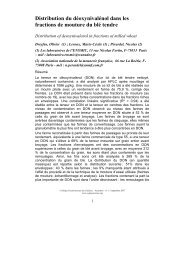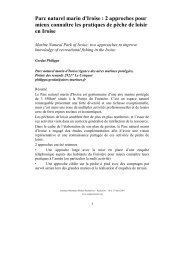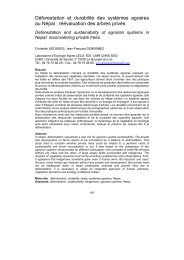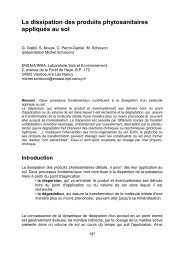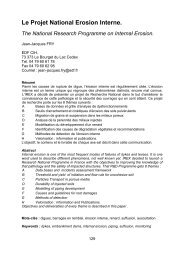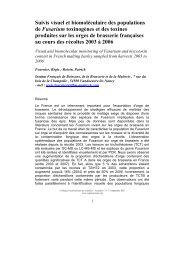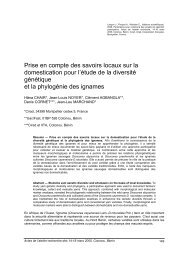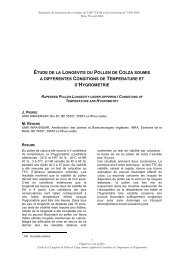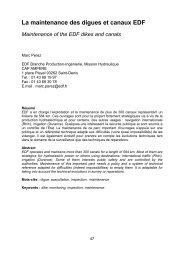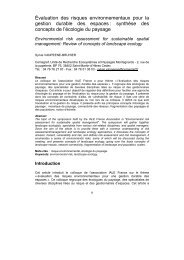Novel analytical methods for Fusarium toxins in the ... - SympoScience
Novel analytical methods for Fusarium toxins in the ... - SympoScience
Novel analytical methods for Fusarium toxins in the ... - SympoScience
You also want an ePaper? Increase the reach of your titles
YUMPU automatically turns print PDFs into web optimized ePapers that Google loves.
<strong>Novel</strong> <strong>analytical</strong> <strong>methods</strong> <strong>for</strong> <strong>Fusarium</strong> <strong>tox<strong>in</strong>s</strong><br />
<strong>in</strong> <strong>the</strong> cereal food cha<strong>in</strong><br />
Nouvelles méthodes pour l’analyse des mycotox<strong>in</strong>es de <strong>Fusarium</strong><br />
dans la chaîne de trans<strong>for</strong>mation des céréales<br />
Visconti, Angelo ; De Girolamo, Annalisa ; Lattanzio, Veronica M. T. ;<br />
Lippolis, V<strong>in</strong>cenzo ; Pascale, Michelangelo ; Solfrizzo, Michele<br />
Institute of Sciences of Food Production, National Research Council<br />
(ISPA-CNR), Via G. Amendola 122/O, 70126, Bari, Italy<br />
e-mail: angelo.visconti@ispa.cnr.it<br />
Abstract<br />
An overview of novel <strong>analytical</strong> <strong>methods</strong> recently developed at ISPA-CNR<br />
<strong>for</strong> <strong>the</strong> determ<strong>in</strong>ation of <strong>the</strong> major <strong>Fusarium</strong> <strong>tox<strong>in</strong>s</strong> occurr<strong>in</strong>g <strong>in</strong> cereals and<br />
cereal-based products is presented. These <strong>methods</strong> deal <strong>in</strong> particular with:<br />
(i) fluorescence polarization (FP) immunoassay <strong>for</strong> rapid quantification of<br />
deoxynivalenol (DON) <strong>in</strong> common wheat, durum wheat, semol<strong>in</strong>a and<br />
pasta; (ii) Fourier trans<strong>for</strong>m-near <strong>in</strong>frared spectroscopy (FT-NIR) <strong>for</strong> rapid,<br />
non-destructive and quantitative determ<strong>in</strong>ation of DON <strong>in</strong> wheat; (iii) HPLC<br />
with fluorescence detection <strong>for</strong> simultaneous determ<strong>in</strong>ation of T-2 tox<strong>in</strong> (T-<br />
2) and HT-2 tox<strong>in</strong> (HT-2) <strong>in</strong> cereal gra<strong>in</strong>s at ppb levels us<strong>in</strong>g immunoaff<strong>in</strong>ity<br />
column clean-up, and specific label<strong>in</strong>g reagents; (iv) liquid chromatographytandem<br />
mass spectrometry (LC-MS/MS) <strong>for</strong> simultaneous determ<strong>in</strong>ation of<br />
DON, nivalenol (NIV), T-2 and HT-2 <strong>in</strong> cereals and cereal-based food<br />
products after extract clean-up by Oasis HLB ® columns and (v) LC-MS/MS<br />
<strong>for</strong> simultaneous determ<strong>in</strong>ation of DON, T-2, HT-2, zearalenone (ZEA) and<br />
fumonis<strong>in</strong>s (FBs), toge<strong>the</strong>r with afla<strong>tox<strong>in</strong>s</strong> (AFs) and ochratox<strong>in</strong> A (OTA), <strong>in</strong><br />
maize after clean-up by a multimycotox<strong>in</strong> immunoaff<strong>in</strong>ity column. Basic<br />
pr<strong>in</strong>ciples, per<strong>for</strong>mances, advantages and limitations of <strong>the</strong>se <strong>methods</strong> are<br />
reviewed.<br />
Keywords: <strong>Fusarium</strong> <strong>tox<strong>in</strong>s</strong>, fluorescence polarization immunoassay, FT-<br />
NIR spectroscopy, LC-MS/MS, multimycotox<strong>in</strong> immunoaff<strong>in</strong>ity columns.<br />
Colloque Fusariotox<strong>in</strong>es des Céréales – Arcachon - 11–13 septembre 2007<br />
www.symposcience.org<br />
1
Résumé<br />
Un panorama des nouvelles méthodes d’analyse développées récemment<br />
par le laboratoire ISPA-CNR pour la quantification des mycotox<strong>in</strong>es de<br />
<strong>Fusarium</strong> ayant la plus <strong>for</strong>te occurrence dans les matrices céréales ou les<br />
produits dérivés est présenté. Ces méthodes sont basées sur différentes<br />
technologies et en particulier: (i) le test immuno-enzymatique à polarisation<br />
de fluorescence (FP) pour la quantification rapide du déoxynivalénol (DON)<br />
dans le blé tendre, le blé dur, les semoules et les pâtes; (ii) la<br />
spectroscopie dans le proche <strong>in</strong>frarouge à trans<strong>for</strong>mée de Fourier (FT-NIR)<br />
pour la déterm<strong>in</strong>ation rapide non-destructive des teneurs en DON dans le<br />
blé; (iii) la CLHP avec détecteur fluorimétrique pour la détection simultanée<br />
de les tox<strong>in</strong>es T2 (T-2) et HT-2 (HT-2) dans les gra<strong>in</strong>s de céréales à des<br />
teneurs de l’ordre du ppb, utilisant des colonnes d’immuno-aff<strong>in</strong>ité pour la<br />
purification et des réactifs spécifiques de marquage ; (iv) la<br />
chromatographie liquide couplée à la spectrométrie de masse en tandem<br />
(LC-MS/MS) pour la détection simultanée du DON, du nivalénol (NIV), T-2<br />
et HT-2 dans les céréales et les aliments à base de céréales en utilisant<br />
des colonnes d’extraction / purification Oasis HLB ® ; (v) LC-MS/MS pour la<br />
déterm<strong>in</strong>ation simultanée de DON, T-2, HT-2, la zéaralénone (ZEA), et les<br />
fumonis<strong>in</strong>es (FBs), ensemble avec les aflatox<strong>in</strong>es (AFs) et l’ochratox<strong>in</strong>e A<br />
(OTA), dans le maïs après purification sur colonne d’immuno-aff<strong>in</strong>ité<br />
multitox<strong>in</strong>es. Les pr<strong>in</strong>cipes de base, les per<strong>for</strong>mances, les avantages et les<br />
<strong>in</strong>convénients de ces méthodes sont passés en revue.<br />
Mots-clés : Tox<strong>in</strong>es de <strong>Fusarium</strong>, immunotest polarisation fluorescence,<br />
spectroscopie FT-NIR, LC-MS/MS, colonne immuno-aff<strong>in</strong>ité multitox<strong>in</strong>es<br />
Introduction<br />
<strong>Fusarium</strong> species are plant pathogens commonly associated with cereals that, under<br />
favourable environmental conditions, can produce several secondary toxic metabolites. The<br />
major <strong>Fusarium</strong> <strong>tox<strong>in</strong>s</strong> found <strong>in</strong> cereals and cereal-based products that can be harmful to<br />
both human and animal health are some tricho<strong>the</strong>cenes, such as deoxynivalenol (DON),<br />
nivalenol (NIV), T-2 tox<strong>in</strong> (T-2), HT-2 tox<strong>in</strong> (HT-2), zearalenone (ZEA) and fumonis<strong>in</strong>s<br />
(FB1, FB2 and FB3) (Visconti, 2001).<br />
The Scientific Committee on Food (SCF) of <strong>the</strong> European Commission has recently given<br />
several op<strong>in</strong>ions on <strong>Fusarium</strong> <strong>tox<strong>in</strong>s</strong> evaluat<strong>in</strong>g DON, ZEA, FB1, FB2 and FB3, NIV, T-2<br />
and HT-2, based on <strong>the</strong> toxicological <strong>in</strong><strong>for</strong>mation available (European Commission,<br />
2006a). In <strong>the</strong>se evaluations <strong>the</strong> Committee established a full Tolerable Daily Intake (TDI)<br />
Colloque Fusariotox<strong>in</strong>es des Céréales – Arcachon - 11–13 septembre 2007<br />
www.symposcience.org<br />
2
<strong>for</strong> DON (1 μg/kg body weight/day) and <strong>for</strong> FB1, FB2 and FB3, alone or <strong>in</strong> comb<strong>in</strong>ation (2<br />
μg/kg b.w./day), and a temporary TDI (t-TDI) <strong>for</strong> NIV (0.7 μg/kg b.w./day) and ZEA (0.2<br />
μg/kg b.w./day) and a comb<strong>in</strong>ed t-TDI <strong>for</strong> T-2 and HT-2 (0.06 μg/kg b.w./day).<br />
A recent SCOOP project, aim<strong>in</strong>g to evaluate <strong>the</strong> risk of dietary exposure to <strong>Fusarium</strong><br />
<strong>tox<strong>in</strong>s</strong> by <strong>the</strong> population of EU member states, showed that <strong>Fusarium</strong> <strong>tox<strong>in</strong>s</strong> are widely<br />
distributed <strong>in</strong> <strong>the</strong> food cha<strong>in</strong> <strong>in</strong> <strong>the</strong> EU and <strong>the</strong> major sources of dietary <strong>in</strong>take of <strong>Fusarium</strong><br />
<strong>tox<strong>in</strong>s</strong> are cereal products, ma<strong>in</strong>ly based on wheat and maize. The dietary <strong>in</strong>takes <strong>for</strong> all<br />
populations and adults were generally below <strong>the</strong> TDIs <strong>for</strong> <strong>the</strong> respective <strong>tox<strong>in</strong>s</strong>, whereas <strong>for</strong><br />
risk groups like <strong>in</strong>fants and young children <strong>the</strong>y were close to or exceeded <strong>the</strong> TDI <strong>in</strong> some<br />
cases (European Commission, 2003).<br />
In order to protect human health from exposure to <strong>the</strong>se myco<strong>tox<strong>in</strong>s</strong> through <strong>the</strong><br />
consumption of cereal-based food products <strong>the</strong> European Commission has recently<br />
established regulatory limits <strong>for</strong> DON, ZEA and fumonis<strong>in</strong>s (sum of FB1 and FB2) <strong>in</strong> raw<br />
materials and products <strong>in</strong>tended <strong>for</strong> human consumption, while permissible levels of T-2<br />
and HT-2 <strong>in</strong> cereal-based products are under discussion (European Commission, 2005;<br />
2006a). The Commission has also issued recommendations to prevent or reduce <strong>the</strong><br />
contam<strong>in</strong>ation of <strong>Fusarium</strong> <strong>tox<strong>in</strong>s</strong> <strong>in</strong> cereals and cereal products (European Commission,<br />
2006b).<br />
There is a need to develop and validate <strong>analytical</strong> <strong>methods</strong> <strong>for</strong> rapid, sensitive and accurate<br />
determ<strong>in</strong>ation of <strong>the</strong>se myco<strong>tox<strong>in</strong>s</strong> <strong>in</strong> cereals and cereal-based products <strong>in</strong> order to properly<br />
assess <strong>the</strong> relevant risk of exposure and to ensure that regulatory levels fixed by <strong>the</strong> EU or<br />
o<strong>the</strong>r <strong>in</strong>ternational organizations are met. Advances <strong>in</strong> <strong>the</strong> analysis of <strong>Fusarium</strong> myco<strong>tox<strong>in</strong>s</strong><br />
<strong>in</strong> cereals and its quality assurance have been reviewed by several authors (Krska et al.,<br />
2001; Pascale & Visconti, 2007; van Osenbruggen & Petterson, 2005). A variety of<br />
emerg<strong>in</strong>g <strong>methods</strong> have been reported <strong>for</strong> <strong>the</strong> rapid analysis of myco<strong>tox<strong>in</strong>s</strong> (<strong>in</strong>clud<strong>in</strong>g<br />
<strong>Fusarium</strong> <strong>tox<strong>in</strong>s</strong>). They are based on novel technologies <strong>in</strong>clud<strong>in</strong>g lateral flow devices<br />
(LFD), membrane-based flow-through enzyme immunoassay, fluorescence polarization<br />
(FP) immunoassay, near-<strong>in</strong>frared spectroscopy (NIR), molecularly impr<strong>in</strong>ted polymers<br />
(MIP) and surface plasmon resonance (SPR) biosensors (Goryacheva et al., 2007; Krska et<br />
al., 2005; Maragos 2004; Pascale & Visconti, 2007; Zheng et al., 2006).<br />
This paper summarizes recent results obta<strong>in</strong>ed <strong>in</strong> our laboratory <strong>in</strong> <strong>the</strong> area of <strong>analytical</strong><br />
chemistry of <strong>Fusarium</strong> myco<strong>tox<strong>in</strong>s</strong> applied to cereals and cereal-based products. In<br />
particular, novel <strong>methods</strong> have been developed based on: fluorescence polarization (FP)<br />
and Fourier trans<strong>for</strong>m-near <strong>in</strong>frared spectroscopy (FT-NIR) <strong>for</strong> rapid quantification of<br />
DON <strong>in</strong> wheat and derived products; HPLC with fluorescence detection <strong>for</strong> simultaneous<br />
determ<strong>in</strong>ation of T-2 and HT-2 <strong>in</strong> cereal gra<strong>in</strong>s; liquid chromatography-tandem mass<br />
spectrometry (LC-MS/MS) <strong>for</strong> simultaneous determ<strong>in</strong>ation of DON, NIV, T-2 and HT-2 <strong>in</strong><br />
cereals and cereal-based food products after Oasis HLB ® columns clean-up, and <strong>for</strong><br />
simultaneous determ<strong>in</strong>ation of DON, T-2, HT-2, ZEA and FBs, toge<strong>the</strong>r with afla<strong>tox<strong>in</strong>s</strong><br />
(AFs) and ochratox<strong>in</strong> A (OTA), <strong>in</strong> maize after multimycotox<strong>in</strong> immunoaff<strong>in</strong>ity column<br />
clean-up.<br />
Colloque Fusariotox<strong>in</strong>es des Céréales – Arcachon - 11–13 septembre 2007<br />
www.symposcience.org<br />
3
1. Fluorescence polarization immunoassay <strong>for</strong> rapid<br />
quantification of deoxynivalenol <strong>in</strong> wheat and derived<br />
products<br />
Fluorescence polarization (FP) immunoassay is a rapid technique measur<strong>in</strong>g <strong>in</strong>teractions<br />
between a fluorescently labelled antigen (tracer) and a specific antibody, and has been<br />
extensively used <strong>in</strong> human and veter<strong>in</strong>ary diagnostics.<br />
Only recently FP immunoassays have been reported <strong>for</strong> <strong>the</strong> analysis of myco<strong>tox<strong>in</strong>s</strong>,<br />
<strong>in</strong>clud<strong>in</strong>g AFs, FBs, ZEA, OTA and DON, although <strong>the</strong>ir application to cereal samples<br />
resulted <strong>in</strong> poor accuracy and sensitivity (Maragos & Plattner, 2002; Maragos & Kim,<br />
2004; Nasir & Jolley, 2003; Shim et al., 2004). In particular, <strong>the</strong> FP immunoassay<br />
developed <strong>for</strong> screen<strong>in</strong>g DON <strong>in</strong> wheat kernels, when compared with an HPLC/UV<br />
method, showed an overestimation of DON <strong>in</strong> naturally contam<strong>in</strong>ated samples which did<br />
not allow accurate measurements of <strong>the</strong> tox<strong>in</strong> at levels close to <strong>the</strong> EU regulatory limits<br />
(Maragos & Plattner, 2002).<br />
We have developed an FP immunoassay <strong>for</strong> <strong>the</strong> determ<strong>in</strong>ation of DON <strong>in</strong> common wheat,<br />
durum wheat, semol<strong>in</strong>a and pasta (Lippolis et al., 2006). The FP immunoassay was based<br />
on <strong>the</strong> competition <strong>for</strong> a DON specific monoclonal antibody between DON and a DONfluorescent<br />
tracer obta<strong>in</strong>ed by selective reaction of DON (at <strong>the</strong> C-3 hydroxyl position) with<br />
4’-(am<strong>in</strong>omethyl)fluoresce<strong>in</strong>. The <strong>analytical</strong> method consisted of a rapid extraction of DON<br />
with phosphate buffered sal<strong>in</strong>e (PBS), followed by filtration through paper and glass<br />
microfibre filters and FP immunoassay quantification. The overall time <strong>for</strong> DON analysis<br />
<strong>in</strong> wheat based products, <strong>in</strong>clud<strong>in</strong>g sample preparation and FP immunoassay measurement,<br />
was about 10 m<strong>in</strong>utes (Lippolis et al., 2006).<br />
By comparison with a validated HPLC/immunoaff<strong>in</strong>ity clean-up method (Mac Donald et<br />
al., 2005), a consistent overestimation of DON content was observed <strong>in</strong> both spiked and<br />
naturally contam<strong>in</strong>ated samples of durum wheat, common wheat, semol<strong>in</strong>a and pasta (free<br />
of 3-acetyl-DON and 15-acetyl-DON). The FP background signal was accurately measured<br />
(FP analysis of 150 samples at different DON spik<strong>in</strong>g levels and different amounts of<br />
analyzed matrix) and shown to be directly proportional to <strong>the</strong> amount of analyzed matrix<br />
<strong>in</strong>dependent of <strong>the</strong> real DON content <strong>in</strong> <strong>the</strong> sample. These results showed that DON<br />
overestimation was due to a matrix effect and could not be attributed to <strong>the</strong> presence of<br />
o<strong>the</strong>r fungal metabolites that cross-react with <strong>the</strong> DON antibody, as previously<br />
hypo<strong>the</strong>sized (Maragos & Plattner, 2002). After subtract<strong>in</strong>g <strong>the</strong> DON background level <strong>for</strong><br />
common wheat (0.39 µg/g DON), durum wheat (0.27 µg/g DON), semol<strong>in</strong>a (0.08 µg/g<br />
DON) and pasta (0.04 µg/g DON), average recoveries (from samples spiked at levels<br />
rang<strong>in</strong>g from 0.25 to 1.75 µg/g) were 100%, 98%, 102% and 101%, respectively, with<br />
relative standard deviations (RSD) lower than 5% (n = 4). The limit of detection (calculated<br />
as three standard deviations of <strong>the</strong> FP signal of <strong>the</strong> “blank” sample, n = 10) was 0.08 µg/g<br />
<strong>for</strong> all matrices, and <strong>the</strong> applicability range of <strong>the</strong> assay was from 0.08 to 2.00 µg/g DON.<br />
Comparative analyses of naturally contam<strong>in</strong>ated samples of durum wheat, common wheat,<br />
semol<strong>in</strong>a and pasta showed a good correlation (r > 0.9955) between DON concentrations<br />
Colloque Fusariotox<strong>in</strong>es des Céréales – Arcachon - 11–13 septembre 2007<br />
www.symposcience.org<br />
4
obta<strong>in</strong>ed by <strong>the</strong> FP immunoassay (after subtract<strong>in</strong>g <strong>the</strong> DON background level) or <strong>the</strong><br />
HPLC/immunoaff<strong>in</strong>ity clean-up method.<br />
The optimized FP method <strong>for</strong> <strong>the</strong> determ<strong>in</strong>ation of DON <strong>in</strong> wheat and derived products<br />
showed better sensitivity and accuracy with respect to <strong>the</strong> previously reported FP<br />
immunoassay and better accuracy and precision with respect to <strong>the</strong> HPLC/immunoaff<strong>in</strong>ity<br />
clean-up method.<br />
In addition, a fully automated FP prototype (European patent pend<strong>in</strong>g) has been developed<br />
<strong>in</strong> our laboratory by assembl<strong>in</strong>g an FP reader with an autosampler assisted by a PC through<br />
a specific software <strong>for</strong> data handl<strong>in</strong>g (Figure 1). The automated FP immunoassay system<br />
offers a rapid, high-throughput, reliable and easy-to-use tool <strong>for</strong> monitor<strong>in</strong>g DON <strong>in</strong> wheatbased<br />
products <strong>in</strong> order to fulfill regulatory levels and protect consumer health from <strong>the</strong> risk<br />
of exposure to <strong>the</strong> tox<strong>in</strong>. The assay is easy to per<strong>for</strong>m, and is quite useful <strong>for</strong> DON<br />
screen<strong>in</strong>g at levels that occur naturally <strong>in</strong> wheat and wheat based products.<br />
Figure 1. The automated FP prototype <strong>for</strong> <strong>the</strong> determ<strong>in</strong>ation of DON.<br />
2. Fourier trans<strong>for</strong>m-near <strong>in</strong>frared spectroscopy <strong>for</strong><br />
rapid determ<strong>in</strong>ation of deoxynivalenol <strong>in</strong> wheat<br />
In <strong>the</strong> past few decades, an <strong>in</strong>creas<strong>in</strong>g use of <strong>in</strong>frared spectroscopy as a rapid and nondestructive<br />
technology is be<strong>in</strong>g recorded <strong>for</strong> <strong>the</strong> analysis of different compounds <strong>in</strong> a broad<br />
Colloque Fusariotox<strong>in</strong>es des Céréales – Arcachon - 11–13 septembre 2007<br />
www.symposcience.org<br />
5
ange of foods. Recently, <strong>the</strong> use of near-<strong>in</strong>frared (NIR) and mid-<strong>in</strong>frared (MIR)<br />
spectroscopy has been evaluated also <strong>for</strong> rapid determ<strong>in</strong>ation of myco<strong>tox<strong>in</strong>s</strong> <strong>in</strong> cereals. NIR<br />
transmittance was used <strong>for</strong> <strong>the</strong> determ<strong>in</strong>ation of DON <strong>in</strong> wheat kernels at levels above 500<br />
µg/kg (Petterson & Aberg, 2003). O<strong>the</strong>r authors reported <strong>the</strong> use of NIR reflectance<br />
measurements <strong>for</strong> prediction of scab, DON and ergosterol content <strong>in</strong> s<strong>in</strong>gle kernels of<br />
highly <strong>in</strong>fected wheat (Delwiche & Hareland, 2004; Dowell et al., 1999). NIR reflectance<br />
spectroscopy was used also to monitor mold contam<strong>in</strong>ation <strong>in</strong> post-harvest maize and to<br />
segregate FB1 contam<strong>in</strong>ated maize from uncontam<strong>in</strong>ated maize (Berardo et al., 2005). A<br />
method <strong>for</strong> <strong>the</strong> detection of <strong>Fusarium</strong> contam<strong>in</strong>ation on maize us<strong>in</strong>g Fourier trans<strong>for</strong>m<br />
(FT)-MIR spectroscopy with attenuated total reflection (ATR) was also described. The<br />
method enabled <strong>the</strong> segregation of DON contam<strong>in</strong>ated maize from uncontam<strong>in</strong>ated one<br />
(Kos et al., 2007). FT-MIR-ATR was also used <strong>for</strong> <strong>the</strong> determ<strong>in</strong>ation of afla<strong>tox<strong>in</strong>s</strong> <strong>in</strong><br />
groundnut and groundnut cakes (Mirghani et al., 2001).<br />
A rapid method us<strong>in</strong>g FT-NIR has been developed <strong>in</strong> our laboratory <strong>for</strong> <strong>the</strong> quantitative<br />
determ<strong>in</strong>ation of DON <strong>in</strong> durum and common wheat.<br />
Partial Least Square (PLS) regression models were built <strong>in</strong> <strong>the</strong> spectral range 10000 - 4000<br />
cm -1 by us<strong>in</strong>g 16 and 31 ground calibration samples of durum wheat (cv. Duilio) and<br />
common wheat (cv. Serio), respectively, with particle size < 500 µm (Cyclotec mill,<br />
Tecator, Sweden). Mean DON levels ranged from 188 to 2100 µg/kg <strong>in</strong> durum wheat and<br />
from not detected (< 80 µg/kg) to 1741 µg/kg <strong>in</strong> common wheat. DON reference<br />
measurements were per<strong>for</strong>med by HPLC (Mac Donald et al., 2005). Correlation<br />
coefficients between reference DON measurements and FT-NIR predicted DON levels, root<br />
mean square error of calibration (RMSEC), root mean square error of cross-validation<br />
(RMSECV) and bias showed a good quality of <strong>the</strong> regression models. The predicted<br />
residual error sum of squares (PRESS) value was used as a good <strong>in</strong>dicator of <strong>the</strong><br />
measurement uncerta<strong>in</strong>ty of <strong>the</strong> model to predict bl<strong>in</strong>d samples. In <strong>the</strong> development of <strong>the</strong><br />
calibration models, 10 partial least squares (PLS) factors were set up as a maximum<br />
number to work with. FT-NIR spectra were recorded us<strong>in</strong>g an Antaris II FT-NIR<br />
spectrophotometer (Thermo Electron Corporation, USA) equipped with an <strong>in</strong>terferometer,<br />
an <strong>in</strong>tegrat<strong>in</strong>g sphere work<strong>in</strong>g <strong>in</strong> diffuse reflection, and an <strong>in</strong>dium and gallium arsenide<br />
(InGaAs) detector.<br />
PLS regressions had correlation coefficients (r) of 0.996 <strong>for</strong> both durum and common<br />
wheat, whereas RMSEC and RMSECV were 55 µg/kg and 350 µg/kg DON <strong>in</strong> durum<br />
wheat, and 50 µg/g and 319 µg/kg <strong>in</strong> common wheat, respectively. PLS regression models<br />
were validated <strong>in</strong> <strong>the</strong> range of 250-1,160 µg/kg <strong>for</strong> durum wheat and 0-1,260 µg/kg <strong>for</strong><br />
common wheat.<br />
The ability of <strong>the</strong> FT-NIR to qualitatively discrim<strong>in</strong>ate between blank (< 80 µg/kg DON)<br />
and naturally contam<strong>in</strong>ated durum wheat and common wheat samples (ground at <strong>the</strong> same<br />
particle sizes, < 500 µm) belong<strong>in</strong>g to different cultivars was evaluated by discrim<strong>in</strong>ant<br />
analysis. A total of 48 durum wheat and 47 common wheat samples were analyzed <strong>for</strong><br />
DON by <strong>the</strong> HPLC reference method, and samples were split <strong>in</strong> two classes, one relevant to<br />
blank samples and <strong>the</strong> o<strong>the</strong>r one relevant to naturally contam<strong>in</strong>ated samples. Two<br />
additional classes were obta<strong>in</strong>ed by spik<strong>in</strong>g some blank wheat samples (durum and<br />
common wheat) with DON standard solutions at levels rang<strong>in</strong>g from 200 to 10000 µg/kg.<br />
Wheat samples were classified as members of each group based on <strong>the</strong> lowest<br />
Colloque Fusariotox<strong>in</strong>es des Céréales – Arcachon - 11–13 septembre 2007<br />
www.symposcience.org<br />
6
correspond<strong>in</strong>g Mahalanobis distance, i.e. <strong>the</strong> multi-dimensional space whose boundaries<br />
determ<strong>in</strong>e <strong>the</strong> variation range. Discrim<strong>in</strong>ant analysis correctly discrim<strong>in</strong>ated durum wheat<br />
from common wheat samples as well as contam<strong>in</strong>ated from blank samples. The two classes<br />
of spiked samples were also well identified. Only 4.2% of both durum and common<br />
contam<strong>in</strong>ated wheat samples were misclassified as blank samples.<br />
Figure 2 shows <strong>the</strong> score/score plot of PC1 and PC2 result<strong>in</strong>g from <strong>the</strong> discrim<strong>in</strong>ant<br />
analysis, <strong>in</strong>dicat<strong>in</strong>g that PC1 and PC2 accounted <strong>for</strong> 69.0% and 26.5%, respectively, of <strong>the</strong><br />
total variance.<br />
Common wheat<br />
Naturally<br />
contam<strong>in</strong>ated<br />
Spiked<br />
Blank<br />
Figure 2. Score/score plot of spectral data (PC1 vs PC2) of 48 durum wheat samples and 47 common<br />
wheat samples belong<strong>in</strong>g to different varieties. The two clusters represent common (left) and durum<br />
(right) wheat both conta<strong>in</strong><strong>in</strong>g blank (≤ 80 µg/kg DON), spiked and naturally contam<strong>in</strong>ated samples.<br />
3. HPLC with fluorescence detection <strong>for</strong><br />
simultaneous determ<strong>in</strong>ation of T-2 and HT-2 <strong>tox<strong>in</strong>s</strong> <strong>in</strong><br />
cereal gra<strong>in</strong>s<br />
Gas-chromatography (GC) with electron-capture (ECD) or mass spectrometric (MS)<br />
detection is largely used <strong>for</strong> quantification of type-A tricho<strong>the</strong>cenes (<strong>in</strong>clud<strong>in</strong>g T-2 and HT-<br />
2). A comparative collaborative study supported by <strong>the</strong> EU showed poor method<br />
per<strong>for</strong>mances <strong>in</strong> GC analysis of tricho<strong>the</strong>cenes <strong>in</strong> terms of recovery, accuracy, and<br />
precision. The ma<strong>in</strong> problems were attributed to matrix <strong>in</strong>terferences giv<strong>in</strong>g rise to<br />
tricho<strong>the</strong>cene response enhancement (Petterson & Langseth, 2002). Liquid chromatography<br />
Colloque Fusariotox<strong>in</strong>es des Céréales – Arcachon - 11–13 septembre 2007<br />
www.symposcience.org<br />
7<br />
Naturally<br />
contam<strong>in</strong>ated<br />
Spiked<br />
Durum wheat<br />
Blank
coupled with mass spectrometry (LC/MS) has been recently applied to <strong>the</strong> simultaneous<br />
determ<strong>in</strong>ation of major type-A and type-B tricho<strong>the</strong>cenes as well as zearalenone, but<br />
problems of accuracy due to matrix effects were observed (Berthiller et al., 2005).<br />
HPLC with fluorescence detection (FD) provides high sensitivity, selectivity and<br />
repeatability of measurements, but it is not applicable to <strong>the</strong> detection of tricho<strong>the</strong>cenes<br />
lack<strong>in</strong>g of fluorophore groups <strong>in</strong> <strong>the</strong>ir chemical structure. The simultaneous determ<strong>in</strong>ation<br />
of T-2, HT-2, T-2 triol and T-2 tetraol by HPLC/FD was reported us<strong>in</strong>g pre-column<br />
derivatization with coumar<strong>in</strong>-3-carbonyl chloride as fluorescence label (Cohen & Bout<strong>in</strong>-<br />
Muma, 1992). This derivatiz<strong>in</strong>g reaction was used <strong>for</strong> develop<strong>in</strong>g a method <strong>for</strong> <strong>the</strong><br />
determ<strong>in</strong>ation of T-2, HT-2, neosolaniol and diacetoxyscirpenol <strong>in</strong> cereal cultures of<br />
<strong>Fusarium</strong> sporotrichioides on maize, rice and wheat by HPLC/FD after solid phase<br />
extraction (SPE) column clean-up. Although <strong>the</strong> method had good sensitivity with standard<br />
<strong>tox<strong>in</strong>s</strong>, when applied to cereal samples it showed poor tox<strong>in</strong> recoveries (Mateo et al., 2002).<br />
Recently we have shown 1-anthroylnitrile (1-AN) to be an efficient fluorescent labell<strong>in</strong>g<br />
reagent <strong>for</strong> T-2 and HT-2 under mild conditions (Visconti et al., 2005). The derivatiz<strong>in</strong>g<br />
reaction was used to develop a sensitive, reproducible and accurate method <strong>for</strong> <strong>the</strong><br />
simultaneous determ<strong>in</strong>ation of T-2 and HT-2 <strong>in</strong> wheat, maize and barley by HPLC/FD after<br />
immunoaff<strong>in</strong>ity column clean-up. Recoveries from spiked samples with tox<strong>in</strong> levels from<br />
25 to 500 µg/kg ranged from 70 to 100%, with relative standard deviations (RSD) lower<br />
than 8%. The method allowed <strong>the</strong> determ<strong>in</strong>ation of T-2 and HT-2 at levels of 5 µg/kg and 3<br />
µg/kg (based on a signal-to-noise ratio of 3), respectively. However, <strong>the</strong> method did not<br />
allow <strong>the</strong> determ<strong>in</strong>ation of HT-2 <strong>in</strong> oats because of <strong>in</strong>terfer<strong>in</strong>g chromatographic peaks<br />
occurr<strong>in</strong>g at <strong>the</strong> retention time of <strong>the</strong> HT-2-(1-AN) derivative (Visconti et al., 2005).<br />
1-anthroyl cyanide<br />
(1-anthroylnitrile, 1-AN)<br />
COCl<br />
COCN<br />
1-naphthoyl chloride<br />
(1-NC)<br />
Colloque Fusariotox<strong>in</strong>es des Céréales – Arcachon - 11–13 septembre 2007<br />
www.symposcience.org<br />
8<br />
COCN<br />
pyrene 1-carbonyl cyanide<br />
(PCC)<br />
COCl<br />
2-naphthoyl chloride<br />
(2-NC)<br />
Figure 3. Fluorescence label<strong>in</strong>g reagents <strong>for</strong> T-2 and HT-2 <strong>tox<strong>in</strong>s</strong>
In order to improve <strong>the</strong> detection limit of <strong>the</strong> HPLC/FD method <strong>for</strong> T-2 and HT-2 <strong>in</strong><br />
foodstuffs, <strong>in</strong>clud<strong>in</strong>g oats, three different commercially available fluorescent reagents were<br />
tested as labell<strong>in</strong>g dyes (Figure 3). 1-naphthoyl chloride (1-NC), 2-naphthoyl chloride (2-<br />
NC) and pyrene-1-carbonyl cyanide (PCC) reacted with <strong>the</strong> hydroxyl groups of T-2 and<br />
HT-2 under mild conditions to <strong>for</strong>m <strong>the</strong> correspond<strong>in</strong>g esters (Lippolis et al., 2007). A wide<br />
l<strong>in</strong>ear range (10-1000 ng <strong>for</strong> ei<strong>the</strong>r T-2 or HT-2 derivatized tox<strong>in</strong>), good repeatability (RSD<br />
≤ 8%) of <strong>the</strong> reaction, and good stability (up to 2 weeks at -20°C and five days at room<br />
temperature) of <strong>the</strong> fluorescent derivatives were observed. Detection limits were 10.0, 6.3<br />
and 2.0 ng <strong>for</strong> derivatized T-2, and 6.3, 2.3 and 2.8 ng <strong>for</strong> derivatized HT-2 with 1-NC, 2-<br />
NC and PCC, respectively. A higher fluorescent <strong>in</strong>tensity was observed <strong>for</strong> derivatives<br />
obta<strong>in</strong>ed by reaction of T-2 and HT-2 with PCC as compared to those obta<strong>in</strong>ed with 1-AN.<br />
Prelim<strong>in</strong>ary studies showed <strong>the</strong> applicability of <strong>the</strong> new labell<strong>in</strong>g reagents (PCC or 2-NC)<br />
<strong>for</strong> <strong>the</strong> simultaneous determ<strong>in</strong>ation of T-2 and HT-2 by HPLC/FD after immunoaff<strong>in</strong>ity<br />
column clean up <strong>in</strong> naturally contam<strong>in</strong>ated cereal gra<strong>in</strong>s, <strong>in</strong>clud<strong>in</strong>g oats (Lippolis et al.,<br />
2007).<br />
4. Liquid chromatography-tandem mass<br />
spectrometry <strong>for</strong> simultaneous determ<strong>in</strong>ation of<br />
<strong>Fusarium</strong> <strong>tox<strong>in</strong>s</strong><br />
Liquid chromatography-tandem mass spectrometry (LC-MS/MS) is spread<strong>in</strong>g rapidly <strong>in</strong>to<br />
<strong>the</strong> field of mycotox<strong>in</strong> analysis. Besides <strong>the</strong> high sensitivity, tandem mass spectrometry<br />
provides also <strong>the</strong> highest degree of certa<strong>in</strong>ty <strong>in</strong> analyte identification and may be employed<br />
<strong>in</strong> accordance with recent European Union guidel<strong>in</strong>es to obta<strong>in</strong> data with relevant<br />
unambiguity (European Commission, 2002). Moreover, <strong>the</strong> high selectivity of LC-MS/MS<br />
<strong>in</strong>struments enables to reduce or even omit sample preparation, <strong>in</strong>creas<strong>in</strong>g sample<br />
throughput. An overview on <strong>the</strong> application of LC-MS <strong>in</strong> <strong>the</strong> analysis of frequently<br />
occurr<strong>in</strong>g myco<strong>tox<strong>in</strong>s</strong>, <strong>in</strong>clud<strong>in</strong>g tricho<strong>the</strong>cenes, FBs and ZEA, has been recently published<br />
(Zöllner & Mayer-Helm, 2006).<br />
4.1. LC-MS/MS <strong>for</strong> simultaneous determ<strong>in</strong>ation of nivalenol,<br />
deoxynivalenol, T-2 and HT-2 <strong>tox<strong>in</strong>s</strong> <strong>in</strong> cereals and cerealbased<br />
products<br />
LC-MS/MS is becom<strong>in</strong>g <strong>the</strong> technique of choice <strong>for</strong> <strong>the</strong> simultaneous determ<strong>in</strong>ation of<br />
type-A and type-B tricho<strong>the</strong>cenes (Berger et al., 1999; Berthiller et al., 2005; Biselli &<br />
Hummert, 2005; Cavaliere et al., 2005) overcom<strong>in</strong>g traditional drawbacks of gas<br />
chromatographic <strong>methods</strong> with respect to recovery, accuracy, and precision of <strong>the</strong><br />
measurements (Petterson & Langseth, 2002). Extract clean-up <strong>for</strong> <strong>the</strong> determ<strong>in</strong>ation of<br />
tricho<strong>the</strong>cenes <strong>in</strong> cereals is frequently done by MycoSep ® #227 columns (Romer Labs,<br />
USA), which have also been successfully applied <strong>in</strong> several LC-MS <strong>methods</strong>, although low<br />
NIV recoveries have been reported (Berthiller, et al. 2005, Biselli & Hummert, 2005).<br />
Colloque Fusariotox<strong>in</strong>es des Céréales – Arcachon - 11–13 septembre 2007<br />
www.symposcience.org<br />
9
An LC-APCI-MS/MS method <strong>for</strong> <strong>the</strong> simultaneous determ<strong>in</strong>ation of NIV, DON, T-2 and<br />
HT-2 <strong>in</strong> cereals and cereal-based foods such as wheat, maize, barley, <strong>in</strong>fant foods, cereal<br />
snacks and biscuits has been recently developed <strong>in</strong> our laboratory (Lattanzio et al. 2007a).<br />
A clean up procedure, based on reversed phase SPE Oasis ® HLB columns (Waters, USA)<br />
was used, allow<strong>in</strong>g good recoveries <strong>for</strong> all studied tricho<strong>the</strong>cenes that vary considerably <strong>in</strong><br />
polarity. In particular, recovery of NIV (<strong>the</strong> most polar tricho<strong>the</strong>cene) resulted significantly<br />
improved as compared with those obta<strong>in</strong>ed by us<strong>in</strong>g MycoSep ® #227 columns <strong>for</strong> extract<br />
clean up. In order to assess its general applicability and robustness among a wide range of<br />
cereals and cereal-based foods, <strong>the</strong> whole <strong>analytical</strong> procedure was validated <strong>in</strong> three<br />
different cereals (wheat, barley and maize) and five cereal based foods (<strong>in</strong>fant semol<strong>in</strong>a,<br />
<strong>in</strong>fant biscuits, bacon biscuits, cocoa wafers and coconut snacks). Mean detection limits,<br />
based on a signal-to-noise ratio of 3, <strong>in</strong> <strong>the</strong> various <strong>in</strong>vestigated matrices, were 3.0 µg/kg<br />
<strong>for</strong> NIV, 4.2 µg/kg <strong>for</strong> DON, 0.8 µg/kg <strong>for</strong> HT-2, and 0.5 µg/g <strong>for</strong> T-2. Mean recovery<br />
values, obta<strong>in</strong>ed from cereals and cereal products spiked with NIV, DON, T-2 and HT-2 at<br />
spik<strong>in</strong>g levels from 10 to 1000 µg/kg, ranged from 72 to 110% with mean RSD lower than<br />
10%.<br />
A new approach <strong>for</strong> matrix effect evaluation has been developed throughout this study.<br />
Matrix effects <strong>in</strong> LC-MS analysis are well known and various approaches have been<br />
proposed to overcome this problem (Biselli & Hummert, 2005; Häubl et al., 2006; Razzazi-<br />
Fazeli et al., 2002; Sulyok et al., 2006). However a detailed <strong>in</strong>vestigation has never been<br />
carried out. A systematic study of matrix effects <strong>in</strong> different cereals and cereal products was<br />
carried out by statistically compar<strong>in</strong>g (Student t test) <strong>the</strong> slopes of standard calibration<br />
curve with matrix-matched calibration curve <strong>for</strong> each of <strong>the</strong> <strong>tox<strong>in</strong>s</strong> and <strong>the</strong> matrices<br />
considered <strong>for</strong> method validation. Statistically significant matrix effects were observed <strong>for</strong><br />
seven out of <strong>the</strong> eight matrices tested, <strong>in</strong>dicat<strong>in</strong>g that <strong>for</strong> accurate quantitative analysis a<br />
matrix-matched calibration is necessary. Moreover, <strong>the</strong> slope of <strong>the</strong> regression varied<br />
considerably from matrix to matrix also reveal<strong>in</strong>g chang<strong>in</strong>g <strong>in</strong>fluences of co-elut<strong>in</strong>g matrix<br />
compounds on <strong>the</strong> analyte signal. On <strong>the</strong> basis of <strong>the</strong>se f<strong>in</strong>d<strong>in</strong>gs we concluded that, due to<br />
<strong>the</strong> observed matrix effects, <strong>the</strong> matrix-matched calibration is necessary <strong>for</strong> reliable<br />
quantitative analyses.<br />
4.2. LC-MS/MS <strong>for</strong> simultaneous determ<strong>in</strong>ation of <strong>Fusarium</strong><br />
<strong>tox<strong>in</strong>s</strong>, afla<strong>tox<strong>in</strong>s</strong> and ochratox<strong>in</strong> A <strong>in</strong> maize<br />
There is currently a strong trend toward multi-mycotox<strong>in</strong> <strong>methods</strong> <strong>for</strong> <strong>the</strong> simultaneous<br />
determ<strong>in</strong>ation of myco<strong>tox<strong>in</strong>s</strong> belong<strong>in</strong>g to different chemical families. This topic has been<br />
recently <strong>in</strong>vestigated by several authors, although major problems related to <strong>the</strong> extraction<br />
and clean up steps have not been adequately undertaken and solved (Cavaliere et al., 2005;<br />
Ren et al., 2007; Sulyok et al., 2007; Tanaka et al., 2006).<br />
An LC-ESI-MS/MS multiresidual method was developed <strong>for</strong> <strong>the</strong> simultaneous<br />
determ<strong>in</strong>ation of all ma<strong>in</strong> <strong>Fusarium</strong> <strong>tox<strong>in</strong>s</strong> (DON, T-2, HT-2, FB1, FB2, ZEA) toge<strong>the</strong>r with<br />
afla<strong>tox<strong>in</strong>s</strong> (AFBB1, AFB2, AFG1, AFG2) and OTA <strong>in</strong> maize (Lattanzio et al., 2007b). A<br />
double extraction, us<strong>in</strong>g PBS and methanol/water, was per<strong>for</strong>med to achieve effective coextraction<br />
of all myco<strong>tox<strong>in</strong>s</strong> under <strong>in</strong>vestigation. For extract clean up a new multitox<strong>in</strong><br />
®<br />
immunoaff<strong>in</strong>ity column (AOFZDT2 , Vicam, USA) conta<strong>in</strong><strong>in</strong>g antibodies <strong>for</strong> all <strong>the</strong>se<br />
Colloque Fusariotox<strong>in</strong>es des Céréales – Arcachon - 11–13 septembre 2007<br />
www.symposcience.org<br />
10
myco<strong>tox<strong>in</strong>s</strong> was successfully used. A typical chromatogram relevant to a maize sample<br />
spiked with <strong>the</strong> 11 myco<strong>tox<strong>in</strong>s</strong> is reported <strong>in</strong> Figure 4.<br />
Method per<strong>for</strong>mances, i.e. recovery, repeatability and l<strong>in</strong>earity over <strong>the</strong> work<strong>in</strong>g range,<br />
were evaluated <strong>for</strong> each tox<strong>in</strong> at contam<strong>in</strong>ation levels comparable with <strong>the</strong> relevant<br />
established or expected EU maximum limits <strong>in</strong> maize (European Commission, 2006a).<br />
Recovery values <strong>for</strong> <strong>the</strong> whole <strong>analytical</strong> procedure ranged from 79% to 104% with RSD<br />
lower than 13% <strong>for</strong> all tested <strong>tox<strong>in</strong>s</strong>. Limits of detection (LOD, signal-to-noise ratio of 3)<br />
were: 4.2 µg/kg <strong>for</strong> DON, 1.1 <strong>for</strong> µg/kg FBB1, 0.4 µg/kg <strong>for</strong> FB2, 1.9 µg/kg <strong>for</strong> HT-2, 1.5<br />
µg/kg <strong>for</strong> T-2, 0.7 µg/kg <strong>for</strong> ZEA, 0.8 µg/kg <strong>for</strong> AFG2, 0.4 µg/kg <strong>for</strong> AFG1, 0.3 µg/kg <strong>for</strong><br />
AFB2, 0.6 µg/kg <strong>for</strong> AFB1B , and 0.6 µg/kg <strong>for</strong> OTA. Based on <strong>the</strong> obta<strong>in</strong>ed LOD values, <strong>the</strong><br />
method allows to assess, <strong>in</strong> a s<strong>in</strong>gle analysis, <strong>the</strong> compliance of maize with <strong>the</strong> EU<br />
maximum permitted levels <strong>for</strong> OTA, DON, and ZEA, while provid<strong>in</strong>g quantitative data on<br />
AFs contam<strong>in</strong>ation at levels slightly above <strong>the</strong> EU regulated levels. It is also quite<br />
satisfactory <strong>for</strong> levels of FBs, T-2 and HT-2 which levels will soon be regulated or are<br />
currently under discussion with<strong>in</strong> <strong>the</strong> EU.<br />
100<br />
%<br />
0<br />
ZEA<br />
(-) (+) (+) (-) (+)<br />
DON<br />
AFG 2<br />
x 3.0<br />
AFG 1<br />
AFB 2<br />
AFB 1<br />
HT-2<br />
FB 1<br />
5 10 15 20 25 30 35 40 45 50 55<br />
Time, m<strong>in</strong><br />
Figure 4. Total ion chromatogram (TIC of MRM) of an extract of maize spiked at levels of 500 µg/kg<br />
DON; 2 µg/kg AFG2, AFBB2; 6 µg/kg AFG1; 10 µg/kg AFB1; 500 µg/kg FB1; 250 µg/kg FB2; 100<br />
µg/kg T-2, HT-2, ZEA; 20 µg/kg OTA;<br />
Vertical l<strong>in</strong>es <strong>in</strong>dicate <strong>the</strong> periods of polarity switch<strong>in</strong>g. HPLC conditions: column: Gem<strong>in</strong>i ® RP18<br />
(150 × 2.0 mm, 5 µm); mobile phase: methanol/water conta<strong>in</strong><strong>in</strong>g 0.5% acetic acid, 1 mM ammonium<br />
acetate, flow rate 200 µl/m<strong>in</strong>, without splitt<strong>in</strong>g (from Lattanzio et al., 2007, Rapid Communications <strong>in</strong><br />
Mass Spectrometry, 21, p. 3253-3261).<br />
T-2<br />
FB 2<br />
OTA<br />
Colloque Fusariotox<strong>in</strong>es des Céréales – Arcachon - 11–13 septembre 2007<br />
www.symposcience.org<br />
11
Conclusions<br />
The novel <strong>analytical</strong> <strong>methods</strong> presented here<strong>in</strong> meet <strong>the</strong> need of quality control laboratories<br />
<strong>for</strong> reliable and rapid (automated) <strong>methods</strong> <strong>for</strong> (simultaneous) determ<strong>in</strong>ation of major<br />
<strong>Fusarium</strong> <strong>tox<strong>in</strong>s</strong> occurr<strong>in</strong>g <strong>in</strong> cereals and cereal-based products (Table 1).<br />
Table 1. Advantages and disadvantages of novel <strong>methods</strong> <strong>for</strong> <strong>Fusarium</strong> <strong>tox<strong>in</strong>s</strong>.<br />
Method <strong>Fusarium</strong><br />
<strong>tox<strong>in</strong>s</strong><br />
Clean-up Advantages Disadvantages<br />
FPIA DON no Rapid<br />
No clean up<br />
Automated<br />
FT-NIR DON no Rapid<br />
No extraction<br />
No clean up<br />
Easy-to-use<br />
HPLC/FD T-2, HT-2 IAC Good sensitivity<br />
Good selectivity<br />
Good repeatability<br />
HPLC/MS-<br />
MS<br />
HPLC/MS-<br />
MS<br />
DON, NIV,<br />
T-2, HT-2<br />
DON, T-2,<br />
HT-2, ZEA,<br />
FB1, FBB2<br />
SPE column<br />
(Oasis ® HLB)<br />
Multimycotox<strong>in</strong><br />
IAC (AOFZDT2 ® )<br />
Colloque Fusariotox<strong>in</strong>es des Céréales – Arcachon - 11–13 septembre 2007<br />
www.symposcience.org<br />
12<br />
Multiple myco<strong>tox<strong>in</strong>s</strong><br />
analysis<br />
Good sensitivity<br />
Analyte confirmation<br />
No derivatization<br />
Antibody crossreactivity<br />
Specific calibration<br />
models needed<br />
Expensive<br />
equipment<br />
Calibration model<br />
validation needed<br />
Statistical basis<br />
required<br />
Expensive<br />
equipment<br />
Derivatization<br />
required<br />
Very expensive<br />
equipment<br />
Expert personnel<br />
Matrix assisted<br />
calibration curve<br />
(see above) (see above)<br />
FPIA = fluorescence polarization immunoassay; FT-NIR = Fourier trans<strong>for</strong>m-near <strong>in</strong>frared<br />
spectroscopy; HPLC/FD = high-per<strong>for</strong>mance liquid chromatography/fluorescence detector;<br />
HPLC/MS-MS = high-per<strong>for</strong>mance liquid chromatography-tandem mass spectroscopy; IAC =<br />
immunoaff<strong>in</strong>ity column; SPE = solid phase extraction.<br />
In particular, <strong>the</strong> fully automated FP immunoassay allows rapid and quantitative<br />
determ<strong>in</strong>ation of DON at levels that can naturally occur <strong>in</strong> wheat and wheat based products,<br />
and can be used as an alternative method to HPLC/immunoaff<strong>in</strong>ity clean-up. The overall<br />
time <strong>for</strong> DON analysis <strong>in</strong> wheat based products, <strong>in</strong>clud<strong>in</strong>g sample preparation and FP
immunoassay measurement, was about 10 m<strong>in</strong>utes, thus allow<strong>in</strong>g a much higher throughput<br />
of analyses as compared to HPLC or GC <strong>methods</strong>.<br />
FT-NIR <strong>in</strong>struments are faster and more sensitive than traditional dispersive NIR<br />
<strong>in</strong>struments and allow simultaneous measurements of full spectra with higher resolution.<br />
FT-NIR spectroscopy is a promis<strong>in</strong>g technique <strong>for</strong> rapid (less than 10 m<strong>in</strong>) and quantitative<br />
determ<strong>in</strong>ation of DON at levels below <strong>the</strong> maximum limits set by <strong>the</strong> European Union <strong>for</strong><br />
unprocessed durum and common wheat.<br />
New fluorescent label<strong>in</strong>g reagents (1-AN, 1-NC, 2-NC and PCC) have been shown to react<br />
with T-2 and HT-2 under mild conditions to give <strong>the</strong> correspond<strong>in</strong>g fluorescent esters.<br />
These reagents have been used to develop and validate a sensitive and accurate <strong>analytical</strong><br />
method <strong>for</strong> <strong>the</strong> simultaneous determ<strong>in</strong>ation of T-2 and HT-2 <strong>in</strong> raw cereals, <strong>in</strong>clud<strong>in</strong>g oats,<br />
by HPLC/FD after immunoaff<strong>in</strong>ity column clean-up.<br />
The potential of LC-MS/MS <strong>for</strong> simultaneous and high sensitive detection of several<br />
<strong>Fusarium</strong> <strong>tox<strong>in</strong>s</strong> (also <strong>in</strong> comb<strong>in</strong>ation with AFs and OTA) <strong>in</strong> cereals and cereal-based<br />
products has also been shown. Different clean up strategies, based on reversed phase SPE<br />
cartridges (Oasis ® HLB) or multi<strong>tox<strong>in</strong>s</strong> immunoaff<strong>in</strong>ity columns (AOFZDT2 ® ) have been<br />
developed <strong>for</strong> one-step purification of several myco<strong>tox<strong>in</strong>s</strong>. Per<strong>for</strong>mance characteristics of<br />
<strong>the</strong> developed <strong>methods</strong> <strong>in</strong>dicate that LC-MS/MS can lead to fully validated <strong>analytical</strong><br />
<strong>methods</strong> accord<strong>in</strong>g to EU requirements <strong>for</strong> certified mycotox<strong>in</strong> analysis.<br />
References<br />
Berardo N., Pisacane V., Battilani P., Scandolara A., Pietri A., Marocco A., 2005. Rapid detection of<br />
kernel rots and myco<strong>tox<strong>in</strong>s</strong> <strong>in</strong> maize by near-<strong>in</strong>frared reflectance spectroscopy. Journal of<br />
Agricultural and Food Chemistry, 53, p. 8128-8134.<br />
Berger U., Oehme M., Kuhn F., 1999. Quantitative determ<strong>in</strong>ation and structure elucidation of type-A<br />
and B-tricho<strong>the</strong>cenes by HPLC/ion trap multiple mass spectrometry. Journal of Agricultural and<br />
Food Chemistry, 47, p. 4240-4245.<br />
Berthiller F., Schuhmacher R., Butt<strong>in</strong>ger G., Krska R., 2005. Rapid simultaneous determ<strong>in</strong>ation of<br />
major type A- and B-tricho<strong>the</strong>cenes as well as zearalenone <strong>in</strong> maize by high per<strong>for</strong>mance liquid<br />
chromatography-tandem mass spectrometry. Journal of Chromatography A, 1062, p. 209-216.<br />
Biselli S., Hummert C., 2005. Development of a multicomponent method <strong>for</strong> <strong>Fusarium</strong> <strong>tox<strong>in</strong>s</strong> us<strong>in</strong>g<br />
LC-MS/MS and its application dur<strong>in</strong>g a survey <strong>for</strong> <strong>the</strong> content of T-2 tox<strong>in</strong> and deoxynivalenol <strong>in</strong><br />
various feed and food samples. Food Additives and Contam<strong>in</strong>ants, 22, p. 752-760.<br />
Cavaliere C., Foglia P., Pastor<strong>in</strong>i E., Saperi R., Laganà A., 2005. Development of a multiresidue<br />
method <strong>for</strong> analysis of major <strong>Fusarium</strong> myco<strong>tox<strong>in</strong>s</strong> <strong>in</strong> corn meal us<strong>in</strong>g liquid<br />
chromatography/tandem mass spectrometry. Rapid Communications <strong>in</strong> Mass Spectrometry, 19, p.<br />
2085-2093.<br />
Cohen H., Bout<strong>in</strong>-Muma B., 1992. Fluorescence detection of tricho<strong>the</strong>cene myco<strong>tox<strong>in</strong>s</strong> as coumar<strong>in</strong>-<br />
3-carbonyl chloride derivatives by high-per<strong>for</strong>mance liquid chromatography. Journal of<br />
Chromatography, 595, p. 143-148.<br />
Delwiche S.R., Hareland G.A., 2004. Detection of scab-damaged hard red spr<strong>in</strong>g wheat kernels by<br />
near-<strong>in</strong>frared reflectance. Cereal Chemistry, 81, p. 643-649.<br />
Dowell F.E., Ram M.S., Seitz M.S., 1999. Predict<strong>in</strong>g scab, vomitox<strong>in</strong>, and ergosterol <strong>in</strong> s<strong>in</strong>gle wheat<br />
kernels us<strong>in</strong>g near-<strong>in</strong>frared spectroscopy. Cereal Chemistry, 76, p. 573-576.<br />
Colloque Fusariotox<strong>in</strong>es des Céréales – Arcachon - 11–13 septembre 2007<br />
www.symposcience.org<br />
13
European Commission, 2002. Decision (EC) No 657/2002 of 12 August 2002 implement<strong>in</strong>g Council<br />
Directive 96/23/EC concern<strong>in</strong>g <strong>the</strong> per<strong>for</strong>mance of <strong>analytical</strong> <strong>methods</strong> and <strong>the</strong> <strong>in</strong>terpretation of<br />
results. Official Journal of <strong>the</strong> European Communities, L 221, p. 8-36.<br />
European Commission, 2003. Reports on tasks <strong>for</strong> scientific cooperation, Task 3.2.10. Collection of<br />
occurrence data of <strong>Fusarium</strong> <strong>tox<strong>in</strong>s</strong> <strong>in</strong> food and assessment of dietary <strong>in</strong>take by <strong>the</strong> population of<br />
EU Members States. http//europa.eu.<strong>in</strong>t/comm./food/fs/scoop/task3210.pdf (pages consulted on<br />
20 th Sept. 2007).<br />
European Commission, 2005. Regulation (EC) No 856/2005 of 6 June 2005 amend<strong>in</strong>g regulation<br />
(EC) No 466/2001 as regards <strong>Fusarium</strong> <strong>tox<strong>in</strong>s</strong>. Official Journal of <strong>the</strong> European Union, L143, p. 3-<br />
8.<br />
European Commission, 2006a. Regulation (EC) No 1881/2006 of 19 December 2006 sett<strong>in</strong>g<br />
maximum levels <strong>for</strong> certa<strong>in</strong> contam<strong>in</strong>ants <strong>in</strong> foodstuffs. Official Journal of <strong>the</strong> European Union,<br />
L364, p. 5-23.<br />
European Commission, 2006b. Recommendation of 17 August 2006 on <strong>the</strong> prevention and reduction<br />
of <strong>Fusarium</strong> <strong>tox<strong>in</strong>s</strong> <strong>in</strong> cereals and cereal products. Official Journal of <strong>the</strong> European Union, L234,<br />
p. 35-40.<br />
Goryacheva I.Y., de Saeger S., Erem<strong>in</strong> S.A., van Peteghem C., 2007. Immunochemical <strong>methods</strong> <strong>for</strong><br />
rapid mycotox<strong>in</strong> detection: Evolution from s<strong>in</strong>gle to multiple analyte screen<strong>in</strong>g – a review. Food<br />
Additives and Contam<strong>in</strong>ants, 24, p. 1169-1183.<br />
Häubl G., Berthiller F., Krska R., Schuhmacher R., 2006. Suitability of a fully 13 C isotope labeled<br />
<strong>in</strong>ternal standard <strong>for</strong> <strong>the</strong> determ<strong>in</strong>ation of <strong>the</strong> mycotox<strong>in</strong> deoxynivalenol by LC-MS/MS without<br />
clean up. Analitycal and Bioanalitycal Chemistry, 384, p. 692-696.<br />
Kos G., Lohn<strong>in</strong>ger H., Mizaikoff B., Krska R., 2007. Optimisation of a sample preparation procedure<br />
<strong>for</strong> <strong>the</strong> screen<strong>in</strong>g of fungal <strong>in</strong>fection and assessment of deoxynivalenol content <strong>in</strong> maize us<strong>in</strong>g mid<strong>in</strong>frared<br />
attenuated total reflection spectroscopy. Food Additives and Contam<strong>in</strong>ants, 24, p. 721-729.<br />
Krska R., Baumgartner S., Josephs R., 2001. The state-of-<strong>the</strong>-art <strong>in</strong> <strong>the</strong> analysis of type-A and -B<br />
tricho<strong>the</strong>cene myco<strong>tox<strong>in</strong>s</strong> <strong>in</strong> cereals. Fresenius' Journal of Analytical Chemistry, 371, p. 285-299.<br />
Krska R., Welzig E., Berthiller F., Mol<strong>in</strong>elli A., Mizaikoff B., 2005. Advances <strong>in</strong> <strong>the</strong> analysis of<br />
myco<strong>tox<strong>in</strong>s</strong> and its quality assurance. Food Additives and Contam<strong>in</strong>ants, 22, p. 345-353.<br />
Lattanzio V.M.T., Solfrizzo M., Visconti A., 2007a. Determ<strong>in</strong>ation of tricho<strong>the</strong>cenes <strong>in</strong> cereals and<br />
cereal-based products by liquid chromatography-tandem mass spectrometry. Food Additives and<br />
Contam<strong>in</strong>ants, (<strong>in</strong> press).<br />
Lattanzio V.M.T., Solfrizzo M., Powers S., Visconti A., 2007b. Simultaneous determ<strong>in</strong>ation of<br />
afla<strong>tox<strong>in</strong>s</strong>, ochratox<strong>in</strong> A and <strong>Fusarium</strong> <strong>tox<strong>in</strong>s</strong> by liquid chromatography/tandem mass spectrometry<br />
after multitox<strong>in</strong> immunoaff<strong>in</strong>ity clean up. Rapid Communications <strong>in</strong> Mass Spectrometry, 21, p.<br />
3253-3261.<br />
Lippolis V., Pascale M., Maragos C.M., Visconti A., 2007. Improvement of detection sensitivity <strong>for</strong><br />
T-2 and HT-2 <strong>tox<strong>in</strong>s</strong> us<strong>in</strong>g different fluorescent label<strong>in</strong>g reagents by high-per<strong>for</strong>mance liquid<br />
chromatography. Talanta, (<strong>in</strong> press).<br />
Lippolis V., Pascale M., Visconti A., 2006. Optimization of a fluorescence polarization immunoassay<br />
<strong>for</strong> rapid quantification of deoxynivalenol <strong>in</strong> durum wheat based products. Journal of Food<br />
Protection, 69, p. 2712-2719.<br />
MacDonald S.J., Chan D., Brereton P., Damant A., Wood R., 2005. Determ<strong>in</strong>ation of deoxynivalenol<br />
<strong>in</strong> cereals and cereal products by immunoaff<strong>in</strong>ity column clean-up with liquid chromatography:<br />
Interlaboratory study. Journal of AOAC International, 88, p. 1197-1204.<br />
Maragos C.M., 2004. Emerg<strong>in</strong>g technologies <strong>for</strong> mycotox<strong>in</strong> detection. Journal of Toxicology, 23, p.<br />
317-344.<br />
Maragos C.M., Plattner R.D., 2002. Rapid fluorescence polarization immunoassay <strong>for</strong> <strong>the</strong> mycotox<strong>in</strong><br />
deoxynivalenol <strong>in</strong> wheat. Journal of Agricultural and Food Chemistry, 50, p. 1827-1832.<br />
Colloque Fusariotox<strong>in</strong>es des Céréales – Arcachon - 11–13 septembre 2007<br />
www.symposcience.org<br />
14
Maragos C.M., Kim E-K., 2004. Detection of zearalenone and related metabolites by fluorescence<br />
polarization immunoassay. Journal of Food Protection, 67, p. 1039-1043.<br />
Mateo J.J., Mateo R., Jiménez M., 2002. Accumulation of type A tricho<strong>the</strong>cenes <strong>in</strong> maize, wheat and<br />
rice by <strong>Fusarium</strong> sporotrichioides isolates under diverse culture conditions. International Journal<br />
of Food Microbiology, 72, p. 115-123.<br />
Mirghani M.E.S., Che Man Y.B., J<strong>in</strong>ap S., Bahar<strong>in</strong> B.S., Bakar J., 2001. A new method <strong>for</strong><br />
determ<strong>in</strong><strong>in</strong>g afla<strong>tox<strong>in</strong>s</strong> <strong>in</strong> groundnut and groundnut cake us<strong>in</strong>g Fourier trans<strong>for</strong>m <strong>in</strong>frared<br />
spectroscopy with attenuated total reflectance. Journal of <strong>the</strong> American Oil Chemists Society, 78, p.<br />
985-992.<br />
Nasir M.S., Jolley M.E., 2003. Fluorescence polarization (FP) assay <strong>for</strong> <strong>the</strong> determ<strong>in</strong>ation of gra<strong>in</strong><br />
myco<strong>tox<strong>in</strong>s</strong> (fumonis<strong>in</strong>s, DON vomitox<strong>in</strong> and afla<strong>tox<strong>in</strong>s</strong>). Comb<strong>in</strong>atorial Chemistry & High<br />
Throughput Screen<strong>in</strong>g, 6, p. 267-273.<br />
Pascale M., Visconti A., 2007. Overview of detection <strong>methods</strong> <strong>for</strong> myco<strong>tox<strong>in</strong>s</strong>, <strong>in</strong>: J.F. Leslie, R.<br />
Bandyopadhyay and A. Visconti (eds.), Myco<strong>tox<strong>in</strong>s</strong>: detection <strong>methods</strong>, management, public health<br />
and agricultural trade. CABI Publish<strong>in</strong>g, Wall<strong>in</strong>g<strong>for</strong>d, U.K., Chapter 15, p. 173-185.<br />
Petterson H., Langseth W. Intercomparison of tricho<strong>the</strong>cene analysis and feasibility to produce<br />
certified calibrants and reference material, BCR In<strong>for</strong>mation, Project reports EUR 20285/1 EN<br />
(part I) and EUR 20285/2 EN (part II), European Commission: Brussels, Belgium, 2002.<br />
Pettersson H., Aberg L., 2003. Near <strong>in</strong>frared spectroscopy <strong>for</strong> determ<strong>in</strong>ation of myco<strong>tox<strong>in</strong>s</strong> <strong>in</strong> cereals.<br />
Food Control, 14, p. 229-232.<br />
Razzazi-Fazeli E., Rabus B., Cecon B., Böhm J., 2002. Simultaneous quantification of Atricho<strong>the</strong>cene<br />
myco<strong>tox<strong>in</strong>s</strong> <strong>in</strong> gra<strong>in</strong>s us<strong>in</strong>g liquid chromatography-atmospheric pressure chemical<br />
ionization mass spectrometry. Journal of Chromatography A, 968, p. 129-142.<br />
Ren Y., Zhang Y., Shao S., Cai Z., Feng L., Pan H., Wang Z., 2007. Simultaneous determ<strong>in</strong>ation of<br />
multi-component mycotox<strong>in</strong> contam<strong>in</strong>ants <strong>in</strong> foods and feeds by ultra-per<strong>for</strong>mance liquid<br />
chromatography tandem mass spectrometry. Journal of Chromatography A, 1143, p. 48-64.<br />
Shim W., Kolosova A.Y., Kim Y., Yang Z., Park S., Erem<strong>in</strong> S.A., Lee I., Chung D., 2004.<br />
Fluorescence polarization immunoassay based on a monoclonal antibody <strong>for</strong> <strong>the</strong> detection of<br />
ochratox<strong>in</strong> A. International Journal of Food Science & Technology, 39, p. 829-837.<br />
Sulyok M., Berthiller F., Krska R., Schuhmacher R., 2006. Development and validation of a liquid<br />
chromatography/tandem mass spectrometric method <strong>for</strong> <strong>the</strong> determ<strong>in</strong>ation of 39 myco<strong>tox<strong>in</strong>s</strong> <strong>in</strong><br />
wheat and maize. Rapid Communications <strong>in</strong> Mass Spectrometry, 20, p. 2649-2659.<br />
Tanaka H., Tak<strong>in</strong>o M., Sugita-Konishi Y., Tanaka T., 2006. Development of a liquid<br />
chromatography/time-of-flight mass spectrometric method <strong>for</strong> <strong>the</strong> simultaneous determ<strong>in</strong>ation of<br />
tricho<strong>the</strong>cenes, zearalenone and afla<strong>tox<strong>in</strong>s</strong> <strong>in</strong> foodstuffs. Rapid Communications <strong>in</strong> Mass<br />
Spectrometry, 20, p. 1422-1428.<br />
van Osenbruggen W.A., Petterson H., 2005. Analysis of relevant <strong>Fusarium</strong> myco<strong>tox<strong>in</strong>s</strong> <strong>in</strong> cereals -<br />
<strong>the</strong> state of <strong>the</strong> art, <strong>in</strong> Scholten O.E., Ruckenbauer P., Visconti A., van Osenbruggen W., den Nijs<br />
A.P.M..(eds.), Food safety of cereals: a cha<strong>in</strong>-wide approach to reduce <strong>Fusarium</strong> myco<strong>tox<strong>in</strong>s</strong>, 84 p.<br />
Visconti A., 2001. Problems associated with <strong>Fusarium</strong> myco<strong>tox<strong>in</strong>s</strong> <strong>in</strong> cereals. Bullet<strong>in</strong> of <strong>the</strong> Institute<br />
<strong>for</strong> Comprehensive Agricultural Sciences K<strong>in</strong>ki University, 9, p. 39-55.<br />
Visconti A., Lattanzio V.M.T., Pascale M., Haidukowski M., 2005. Analysis of T-2 and HT-2 <strong>tox<strong>in</strong>s</strong><br />
<strong>in</strong> cereal gra<strong>in</strong>s by immunoaff<strong>in</strong>ity clean-up and liquid chromatography with fluorescence<br />
detection. Journal of Chromatography A, 1075, p. 151-158.<br />
Zheng M.Z., Richard J.L., B<strong>in</strong>der J., 2006. A review of rapid <strong>methods</strong> <strong>for</strong> <strong>the</strong> analysis of myco<strong>tox<strong>in</strong>s</strong>.<br />
Mycopathologia, 161, p. 261-273.<br />
Zöllner P., Mayer-Helm B., 2006. Trace mycotox<strong>in</strong> analysis <strong>in</strong> complex biological and food matrices<br />
by liquid chromatography-atmospheric pressure ionization tandem mass spectrometry. Journal of<br />
Chromatography A, 1136, p. 123-169.<br />
Colloque Fusariotox<strong>in</strong>es des Céréales – Arcachon - 11–13 septembre 2007<br />
www.symposcience.org<br />
15



